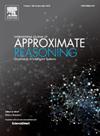加权溯因中假设的逻辑形式化:面向用户反馈对话
IF 3
3区 计算机科学
Q2 COMPUTER SCIENCE, ARTIFICIAL INTELLIGENCE
引用次数: 0
摘要
加权溯因计算解释输入观察的假设。加权溯因推理首先产生可能的假设,然后选择最合理的假设。由于推理器使用称为权重的参数来控制其合理性评估函数,因此它可以根据使用特定于应用程序的权重的特定应用程序输出最合理的假设。这种多功能性使其适用于从工厂操作到网络安全或话语分析。但是,预定的特定于应用程序的权重并不适用于应用程序的所有情况。因此,推理者选择的假设对用户来说不一定是最合理的。为了解决这一问题,本文提出了两种类型的用户反馈对话协议,用户可以积极、消极或中立地指出推理器提出的假设的性质,推理器再生满足用户反馈的假设。由于这是用户反馈对话协议的要求,我们证明:(i)我们的协议必须在某些合理条件下终止;(ii)如果用户根据目标假设是否具有某一属性来确定所指出的每一属性的正性、负性或中性,则它们收敛于与固定目标假设具有相同共同属性的假设。本文章由计算机程序翻译,如有差异,请以英文原文为准。
A logical formalisation of a hypothesis in weighted abduction: Towards user-feedback dialogues
Weighted abduction computes hypotheses that explain input observations. A reasoner of weighted abduction first generates possible hypotheses and then selects the hypothesis that is the most plausible. Since a reasoner employs parameters, called weights, that control its plausibility evaluation function, it can output the most plausible hypothesis according to a specific application using application-specific weights. This versatility makes it applicable from plant operation to cybersecurity or discourse analysis. However, the predetermined application-specific weights are not applicable to all cases of the application. Hence, the hypothesis selected by the reasoner does not necessarily seem the most plausible to the user. In order to resolve this problem, this article proposes two types of user-feedback dialogue protocols, in which the user points out, either positively, negatively or neutrally, properties of the hypotheses presented by the reasoner, and the reasoner regenerates hypotheses that satisfy the user's feedback. As it is required for user-feedback dialogue protocols, we then prove: (i) our protocols necessarily terminate under certain reasonable conditions; (ii) they converge on hypotheses that have the same properties in common as fixed target hypotheses do in common if the user determines the positivity, negativity or neutrality of each pointed-out property based on whether the target hypotheses have that property.
求助全文
通过发布文献求助,成功后即可免费获取论文全文。
去求助
来源期刊

International Journal of Approximate Reasoning
工程技术-计算机:人工智能
CiteScore
6.90
自引率
12.80%
发文量
170
审稿时长
67 days
期刊介绍:
The International Journal of Approximate Reasoning is intended to serve as a forum for the treatment of imprecision and uncertainty in Artificial and Computational Intelligence, covering both the foundations of uncertainty theories, and the design of intelligent systems for scientific and engineering applications. It publishes high-quality research papers describing theoretical developments or innovative applications, as well as review articles on topics of general interest.
Relevant topics include, but are not limited to, probabilistic reasoning and Bayesian networks, imprecise probabilities, random sets, belief functions (Dempster-Shafer theory), possibility theory, fuzzy sets, rough sets, decision theory, non-additive measures and integrals, qualitative reasoning about uncertainty, comparative probability orderings, game-theoretic probability, default reasoning, nonstandard logics, argumentation systems, inconsistency tolerant reasoning, elicitation techniques, philosophical foundations and psychological models of uncertain reasoning.
Domains of application for uncertain reasoning systems include risk analysis and assessment, information retrieval and database design, information fusion, machine learning, data and web mining, computer vision, image and signal processing, intelligent data analysis, statistics, multi-agent systems, etc.
 求助内容:
求助内容: 应助结果提醒方式:
应助结果提醒方式:


